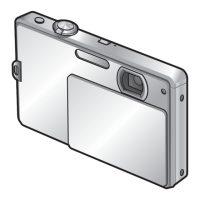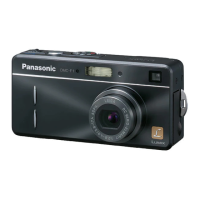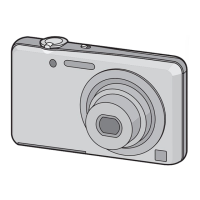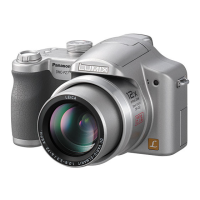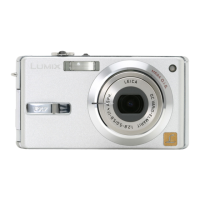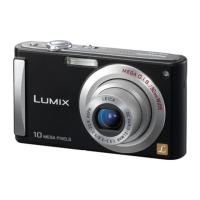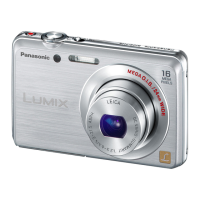
Do you have a question about the Panasonic Lumix DMC-FP3 and is the answer not in the manual?
| Brand | Panasonic |
|---|---|
| Model | Lumix DMC-FP3 |
| Category | Digital Camera |
| Language | English |
Instructions for charging the battery, inserting it and the memory card, and opening the lens cover.
Guide to selecting recording modes, taking pictures, and playback.
Important initial reading instructions before operating the camera.
Guidelines to avoid shocks, moisture, foreign objects, and condensation.
Details on how to touch, drag, and the effective range for touch operations.
Information on using dedicated and compatible batteries safely.
Guidelines on battery life and number of pictures/recording time.
Explanation of saving pictures to built-in memory or memory card.
Details on compatible SD, SDHC, and SDXC memory card types.
Procedure for setting the camera's date, time, and their display format.
Instructions on how to change the clock settings via the SETUP menu.
Overview of the different menu types: REC, PLAYBACK, and SETUP.
Settings for picture preferences, color, sensitivity, and pixel level.
Options for picture protection, cropping, and printing.
Settings for usability, clock, beep sounds, and more.
Setting the date, time, and display format for the camera.
Registering local time for travel destinations.
Adjusting LCD monitor brightness for better visibility.
Resetting camera settings to default values.
List and explanation of available recording modes like Intelligent Auto and Normal Picture.
Turning the camera on by holding the Playback button.
Turning the camera on with the lens cover opened.
How the camera automatically identifies scenes for optimum settings.
Instructions and settings for using the flash in automatic mode.
Using the REC menu to set up recording environment with own preferences.
Adjustments for zoom, flash, brightness, close-up, and coloring.
Automatic playback rotation for vertically taken pictures.
How to use zoom and view zoom ratio and focus range.
Explanation of automatic optical and extended optical zoom functions.
Enlarging pictures during playback and viewing them in list format.
Options to view pictures via slideshow, motion playback, etc.
Procedure for deleting a single picture.
Method for deleting multiple or all pictures at once.
Switching display information for recording and playback modes.
Using guide lines for composition assistance during recording.
Explanation of different flash modes and their applications.
Focus range based on ISO sensitivity and zoom, and available flash types.
Enabling macro mode for close-up photography with AF.
Details on focus range when using AF Macro Mode.
Using Portrait and Soft Skin modes for improved skin tone and smoothing.
Using Scenery for clear distant shots and Sports for fast movement.
Using Night Scenery for clear night shots and Food for natural colors.
Procedure for starting and ending motion picture recording.
Setting the recording quality for motion pictures (HD, WVGA, VGA, QVGA).
Recording travel date and destination for pictures.
Registering local time for travel destinations.
Setting the picture size and its effect on recording capacity.
Manually setting ISO sensitivity for different lighting conditions.
Changing focus alignment method based on subject position and number.
Adjusting coloring to suit light source for natural appearance.
Standard method for viewing pictures one by one.
Automatically playing pictures in order, often with music.
Viewing pictures automatically classified by category.
Viewing only pictures marked as favorites.
Customizing slide show effects, music, and duration.
How to select categories and view pictures accordingly.
Procedure for viewing pictures marked as favorites.
Stamping recording date or registered text onto still pictures.
Reducing picture size for email attachments or homepages.
Setting protection to prevent deletion of important pictures.
Copying pictures between built-in memory and memory card.
Procedure for connecting the camera to a computer via USB.
Using software to import, print, or email pictures.
Steps to connect the camera to a PictBridge-compatible printer.
Instructions for printing multiple pictures and adding dates.
Adjusting print settings like paper size and layout on the camera.
Steps to connect the camera to a TV using the AV cable.
Notes on playing back pictures from SD cards on TVs with card slots.
Explanation of icons and information displayed during recording.
Explanation of icons and information displayed during playback.
Displays related to memory card compatibility and recording failures.
Messages related to battery power and compatibility.
Troubleshooting common problems with power, battery, and recording.
Resolving issues with picture quality, blur, color, and exposure.
Troubleshooting problems related to the LCD monitor display.
Troubleshooting flash not emitting, red-eye, and playback problems.
Troubleshooting camera rattles, heat, lens noise, and touch panel operation.
Resolving clock errors, file number sequence, and card recognition problems.
Precautions for using the camera, including environmental factors and interference.
Instructions for cleaning and maintaining the camera's exterior and finish.
Protecting personal information stored on the camera before disposal or repair.
